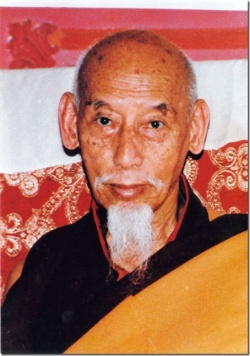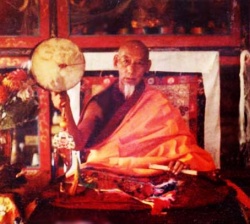Kyabje Zong Rinpoche
A Short Biography of Kyabje Zong Rinpoche
Venerable Kyabje Zong Rinpoche Losan Tsundu Thupten Gyaltsen was born in 1905 in the village of Songo, in the Nang-Sang District of Do-To Kham, Eastern Tibet, into the Nyen Nang-pa Family, near the place where his two previous births, as Tenpa Thuntsok and Phuntsok Chopel, had taken place. His father’s name was Jampa and his mother’s name was Sonam Yangzom.
Near the house of his birth stood a fruit tree which was seen to bear fruit when Rinpoche’s incarnations were alive, but would not bear when he was not on earth.
From birth Rinpoche showed many extraordinary signs. Unlike the other children, his efforts at learning, writing and at memorization required very little effort, and he understood the texts simultaneously to reading them. Thus he studied many texts in the monastery of Nang Sang, near his place of birth.
In 1916 he left his birthplace for Lhasa, Central Tibet. This journey took about three months. Here he entered Ganden Shartse Monastery, one of the three great Lhasa Monastic Colleges. Under many of the greatest living Tibetan masters he studied Tsema (Reason), Parchin (Perfection of Wisdom), Uma (Voidness), Dzö (Metaphysics), and Dùlwa (Discipline). Thus through memorization, recitation and debate he became extremely renowned.
In 1928 Rinpoche appeared before His Holiness the Thirteenth Dalai Lama for his examinations and in 1929 was honoured with the degree of Lharampa Geshe, a sign of total spiritual proficiency in the Sutrayana Methods.
Thereafter, Rinpoche entered the glorious Upper Tantric Monastery where he studied the entire field of Tantras. In this way he became a perfect master of all the teachings of Sutra and Tantra.
In 1937 at the wish and advice of Radrang Rinpoche, Rinpoche accepted the abbotship of Ganden Shartse College, a position at which he served until 1947. During his term he built a new debate stage, reconstructed the old residences of the monks and maintained the monastic discipline perfectly. In 1947 on the occasion of Sangphu Yarchö (an occasion of prayer) he made great offerings to 10,000 monks
From 1947 until 1950 he went to Phagri where there was a monastery called Richung Poto. There he benefitted many sentient beings through his profound teaching. In 1950 he visited Tsari in Southern Tibet. At that time many auspicious signs were manifested. Then he went back to Lhasa. In 1951 he visited Do-To Kham Cha Tring and also his birthplace Nang Sang and other places, where he fulfilled the wish of all people by giving teachings of Lam Rim (Stages on the Path to Enlightenment), Lo Jong (Thought Transformation) and by giving tantric initiations, and by helping them further by performing rituals to eliminate their mental and physical problems.
Then Rinpoche returned to Lhasa where the Red Chinese were very active in suppressing Tibetan culture in the area. This escalated and then culminated in 1959 when the Chinese forces out and out attacked and overthrew the government of free Tibet. Rinpoche left with other Tibetans for India, where he has been residing as a refugee ever since.
In India Rinpoche first stayed at Buxa with many other self-exiled monks of the three great monasteries – Ganden, Sera and Drepung. There he gave teachings, oral transmissions, initiations and so forth.
In 1965, in accordance with the wishes of His Holiness the Fourteenth Dalai Lama, he was appointed as the master of a large group of chosen scholars representing all four sects of Tibetan Buddhism, who convened at Mussoorie to work out patterns of cultural survival for the Tibetan Refugees in India. In 1967 Rinpoche became the first Principal of the Central Institute of High Tibetan Studies at Varanasi’s Sanskrit University.
In 1970 Rinpoche stepped down from this position so as to move to Mundgod in the South of India. From here, Rinpoche travels throughout the different Tibetan refugee settlements and benefits many sentient beings by his teachings and initiations.

